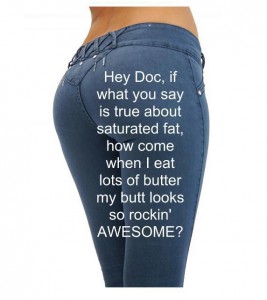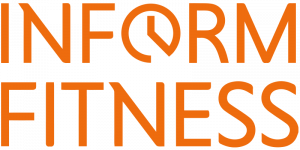![]()
Fat is simply the most misunderstood component of the modern diet, and ‘healthy’ and ‘low-fat’ are dangerously regarded as synonymous.
After years of experts recommending that we eliminate fat completely from our diets, they are now starting to concede that some fats, like Omega-3s, are good for us. Notwithstanding, we are told to proceed with caution and remain rather uninformed as to which fats are ‘good’ and why.
Obesity and heart disease are the associated dark sides of fat. But numerous types of fat, other than the fat that our body’s store, are found in our diet and can either be harmful or beneficial to our health.
Dietary fat from plant and animal food sources is one of the three macronutrients along with protein and carbohydrates that provide energy for your body. The truth is that both our bodies and minds need fat in our diets. Fat is essential to support a number of our body’s functions. In fact, some fats actually promote good health. For instance, some vitamins must have fat to dissolve and nourish the body.
Getting the fats straight and choosing healthier types of dietary fat (and enjoying them) is of vital importance. Here is the basic ‘need-to-know’ on fats to help them work for you, not against you.
Bare ‘Fats’
Although most foods contain several different kinds of fat, in the simplest terms, there are four main types of dietary fat. The ‘solid fats’ are saturated fats and trans fats, which are generally considered harmful. The ‘liquid fats’ are monounsaturated and polyunsaturated fats, which are generally considered potentially helpful.
- Saturated fats come mainly from animal food sources, such as butter, lard, eggs and steak.
- Trans fats are industrial or synthetic.
- Monounsaturated fats are found in a variety of foods and oils, such as nuts and high-fat fruits like avocados and olives.
- Polyunsaturated fats are found mostly in seafood, plant-based foods and oils, such as fish, leafy greens and seeds.
However, what is ‘generally considered’ regarding saturated fats is not exactly so.
Saturated Fats – Not So ‘Bad’ After All
Deep in our consciousness, the following mantra has been embedded: too much fat (especially saturated fat) is bad because fat raises cholesterol, and high cholesterol is bad because it raises the risk of heart disease.
The implied correlation between saturated fat and cholesterol is a scary one, indeed. But, in truth, the correlation is not conclusive of causation – saturated fat does not directly raise cholesterol. The two may even be entirely unrelated.
Essentially, this ‘conventional wisdom’ is why many principles of low-carb diets are generally dismissed as unhealthy. Because people don’t simply cut carbohydrates out of their diets (eating the same amounts of everything else, less the carbs), they consume more protein and fat. My goodness! All that fat will surely kill them quickly with heart attacks. Well, while this logic is conventional, it is not wise, and is fundamentally flawed.
Numerous studies (too many to list) have proven that many saturated fats are good for you and facilitate the following health benefits:
• Absorption of trace minerals
• Formation of cell membrane walls
• Delivery of fat-soluble vitamins such as A, D, E, and K
• Conversion of carotene into vitamin A
• Initiation of the building blocks of hormones
Lauric acid, for example, is a saturated fatty acid found in coconut oil that has immune-system boosting properties, both anti-microbial and anti-viral. Take a look at our recent blog post Commodity Futures for Coconuts: A Shrewd Investment?.
The only fatty acid the body produces is palmitic acid, which is a saturated fat, and together with a system of enzymes creates a variety of fatty acids to serve different positive functions within our bodies. Why would a saturated fat be the only fat that our bodies make naturally from food if it were so inherently bad for us?
An incredibly important point to make is that the ‘fate’ in our bodies of saturated fat ingested depends greatly on what that fat is eaten in conjunction with. If carbohydrates are low, then insulin is low and the saturated fat is handled more efficiently by the body. If grains and sugars are high the effects of saturated fat could very well be poisonous.
Some interesting related trivia: the Eskimo diet consists largely of whale blubber, which is 75 percent saturated fat. The Maasai in Kenya eat beef, drink cattle blood and milk, making up a diet consisting primarily of saturated fat. Interestingly, heart disease and chronic health problems don’t exist in these cultures (and most likely won’t unless a McDonalds opens up nearby). While the entire context of their environments should be considered, what can be drawn is the lack of direct causation between a diet high in saturated fat and heart disease.
The Other ‘Good’ Fats
Unsaturated fats, monounsaturated and polyunsaturated, provide us with essential fatty acids (EFAs), which are broken down into two groups:
- Omega-6 fatty acids: Linoleic acid (LA), which is converted into gamma-linolenic acid (GLA) and arachidonic acid (AA)
- Omega-3 fatty acids: Alpha-linolenic acid (ALA), which is converted into eicosapentaenoic acid (EPA) and docosahexaenoic acid (DHA)
The body cannot make EFAs, so they must be obtained through diet or supplementation. Diets rich in the omega-3 fatty acids offer cardio protection by lowering blood cholesterol and triglyceride levels, reducing blood clotting, and reducing the risk of heart attack and sudden death.
Unsaturated fats are also known to reduce inflammation and are helpful for arthritis and other inflammatory disorders. GLA also reduces inflammation, and prevents clotting, dilates blood vessels, improves skin health, and benefits those with diabetes and arthritis.
What constitutes the optimal dietary intake ratio of Omega-6 to Omega-3 fatty acids is debatable. The general estimate is that we currently consume a ratio of 15:1, whereas many nutritional experts recommend a ratio closer to 4:1 or even 2:1.
But rather than trying to calculate the perfect ratio or intake, I suggest that you aim to consume more Omega-3s from fish and fish oils, flaxseed, hemp, and GLA (borage, blackcurrant, or primrose oil) or from supplements.
Last AND Worst – Trans Fats are Evil…Period!
Trans fats are created when oils are solidified through a chemical process called hydrogenation, such as when vegetable oil is processed to margarine. Trans fats are the enemy and are found in abundance in packaged and processed foods, namely cookies crackers, fried foods, baked goods, and many other snack foods.
When trans fats were first introduced they were thought to be a healthier alternative to saturated fats. This assumption has been found to be disastrously incorrect. Trans fats elevate cholesterol levels increasing the risk for heart disease and heart attack, and are also linked to cancer, particularly breast cancer. In fact, there is no safe limit for trans fats in our diets. You should avoid consuming these dangerous trans fats. Food companies have been making efforts in this area and many packaged foods are now labeled “trans fat free” but it is always preferable to eat fresh, whole food.
The Bottom Line:
Live a healthy life; avoid sugars, processed foods, and grains; eat organic foods, raised and processed in a natural clean way and you will not suffer obesity and heart disease. So to put it in relative terms – give up your sugared grain cereal in the morning in exchange for farm fresh eggs and grass fed beefsteak.
– See more at: https://informfitness.com/blog/the-skinny-on-fats/#sthash.JyFwnuTA.dpuf
![]()









